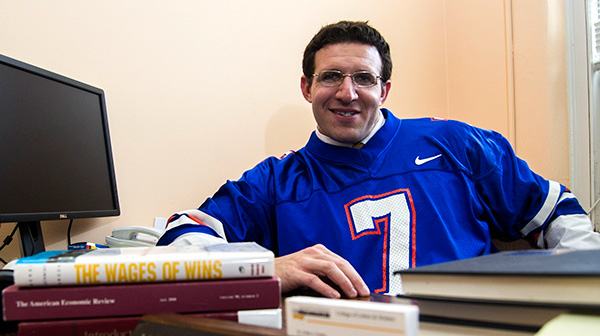
April 30, 2015, is the day college football players nationwide and National Football League fans have been waiting for: the 2015 NFL draft kicks off.
Hundreds of college football players around the country are vying for coveted spots on the nation’s 32 professional football teams. Nearly half of these athletes are black, but the National Collegiate Athletic Association (NCAA) coaching ranks look very different. Less than 15 percent of NCAA Division I (D-I) coaches are black.
And as some of their athletes are preparing for an NFL career, NCAA coaches who are black face racial bias from athletic directors and college and university presidents when it comes to keeping their jobs, says UWM Assistant Africology Professor Nolan Kopkin.
Kopkin analyzed two decades of NCAA D-I football-coach statistics: race, job performance and whether or not a coach had been fired. The Review of Black Political Economy just published Kopkin’s paper, “You’re Fired: The Impact of Race on the Firing of Black Head Coaches in Major College Football.”
Here are four key things Kopkin learned about race, leadership and job security among the NCAA’s top tier of football coaches.
Research shows a bias when it comes to firing coaches
On average, a black head coach will be fired one to two years sooner than a white coach who has a similar job-performance record, says Kopkin. Black head coaches are more likely to be fired in the first three years at a college or university, while the majority of white coaches who are fired are let go in their fourth year.
“By around year four, more than 60 percent of black head coaches have been fired, whereas by year four, less than 40 percent of all white coaches have been fired. You can see very large differences,” Kopkin says. “By year five, over 80 percent of all black head coaches have been fired, but even as late as year eight, less than 80 percent of white coaches have been fired. These differences tend to hold up even after controlling for performance.”
Black coaches tend to be hired into weak football programs
“What the research shows is that black head coaches tend to take over colleges or universities whose football teams aren’t that good. The historical performance of these universities has tended to be a lot worse,” Kopkin says. “Coaches need enough time to recruit their own players. A three- to four-year span is generally what it would take to turn around a program, and it seems as though many black head coaches don’t really get that opportunity to see out their vision of recruiting their own players and building up their team.”
These hiring/firing trends set a bad example for student athletes
Black athletes make up large percentages of college football players overall and represent more than half of all D-I football players, but those demographics are not reflected in athletic leadership. Kopkin hasn’t studied the effect that this might have on players’ ambitions, but he says it’s something that players and coaches should note.
“Most college players do not end up becoming professional athletes. The vast majority do not
make it to the NFL. A lot of them could potentially go into coaching because they know a lot about football,” Kopkin explains. “The fact that most teams don’t have black head coaches might make them feel as though coaching isn’t necessarily a profession they can be successful in. That’s definitely possible.”
Possible solution: NFL’s ‘Rooney Rule’
In 2002, the National Football League instituted the “Rooney Rule,” a stipulation that teams interviewing candidates for coaching positions were required to interview at least one minority candidate, no matter how sure of their hiring decisions they were. As a result, the population of black coaches in the NFL jumped from 6 percent to 22 percent over the last 14 years.
Kopkin’s not sure that instituting a Rooney Rule at the college level would ameliorate the racial bias he’s found in his research, but “it would probably be a step in the right direction toward increasing the number of hires among minority candidates because athletic directors and schools presidents are going to hire a coach they are familiar with,” he says.



